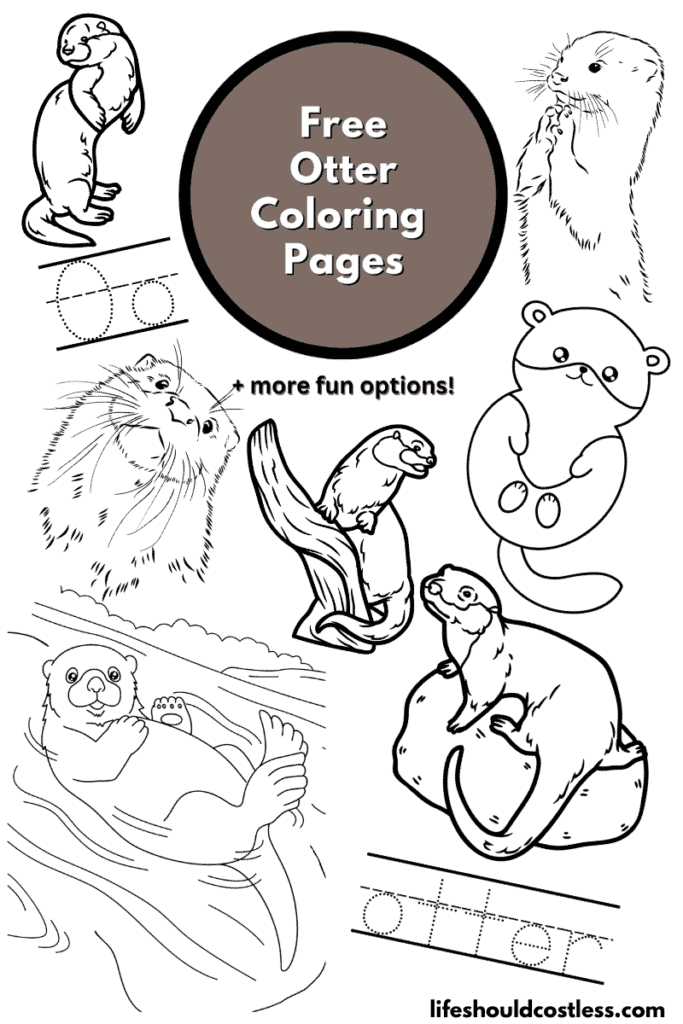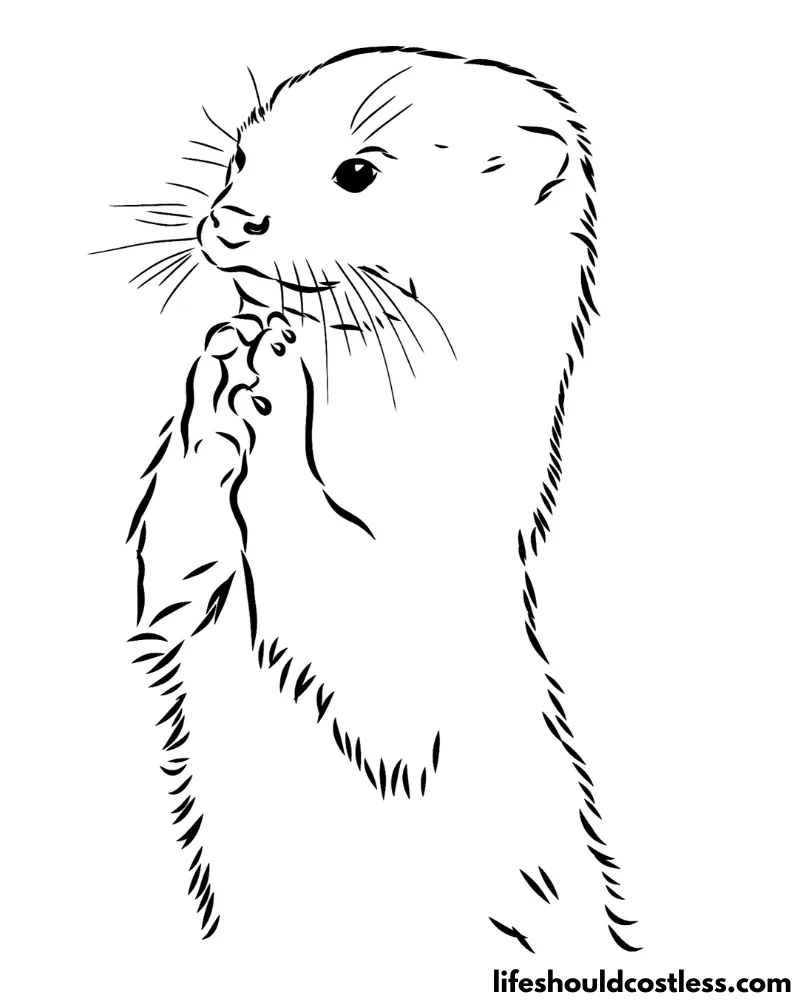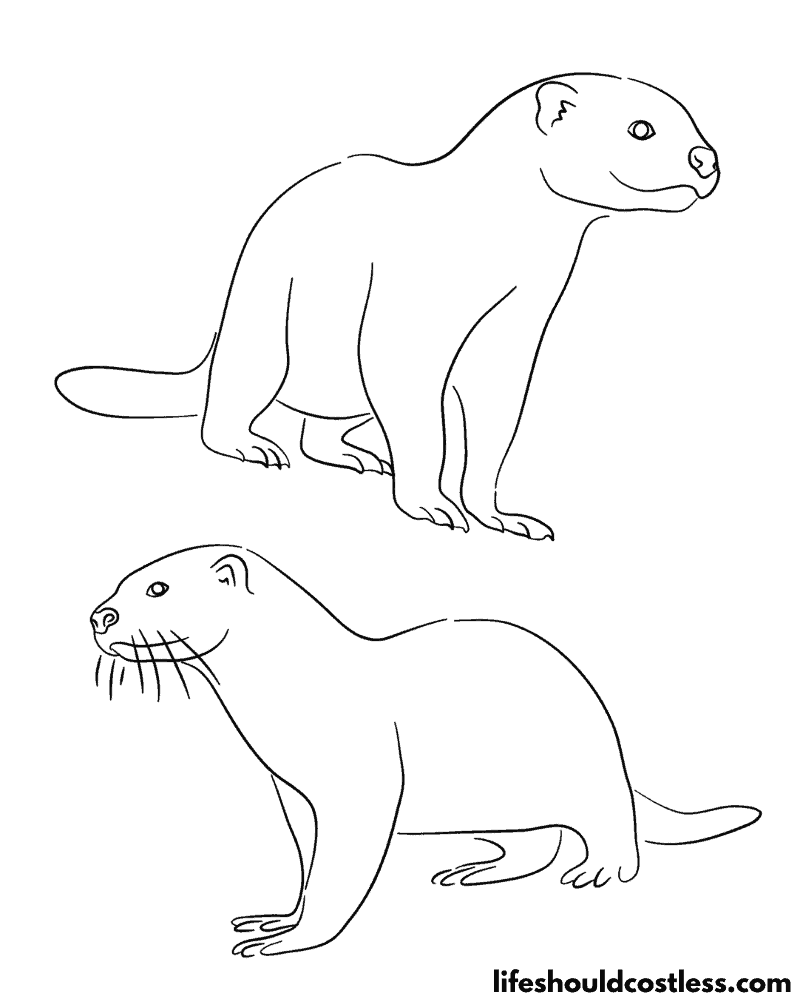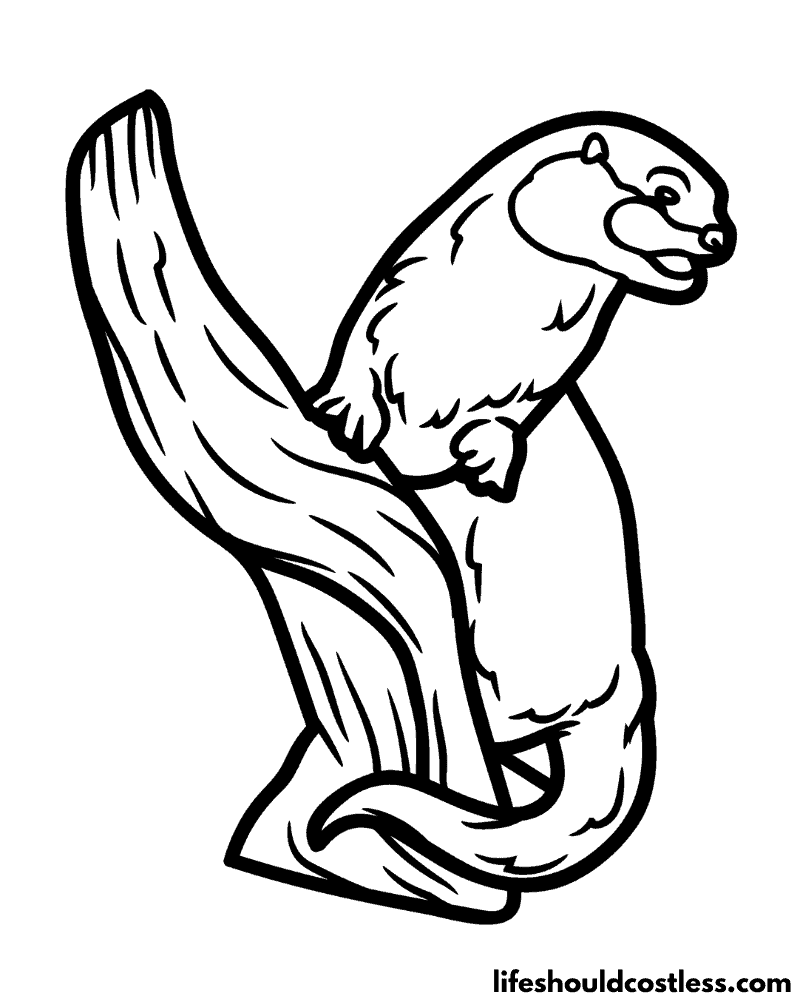Dive into a world of creativity and playfulness with our fun collection of otter coloring pages. These charming aquatic mammals, known for their endearing antics and close-knit family bonds, come to life through intricate outlines awaiting your artistic touch. Whether you’re a young enthusiast discovering the joys of coloring or an adult seeking a soothing and imaginative outlet, our otter-themed coloring pages offer an educationally delightful opportunity to blend hues & bring these delightful creatures to vibrant existence on paper.

Join us in exploring the aquatic world as we delve into the artistic journey that awaits on each page, celebrating the beauty and charm of otters in a colorful and engaging manner.
Feel free to select any design that catches your eye. Simply choose your preferred template, download the complimentary PDF, print it, and let your coloring creativity flow endlessly.
Alternatively, these templates can also serve as embroidery guides or provide inspiration for intricate fine line tattoos. The possibilities are as vast as your imagination allows.
Otter facts
For those who are new to my coloring pages, it’s important to mention that I enjoy providing the opportunity for you to delve into the subject matter.
This way, you can seamlessly transform your coloring experience into an educational journey. With that said, let’s begin!
Here are lots of fun and interesting, simplified, facts about otters:
- Variety of Species: Otters belong to the Mustelidae family, which also includes weasels, badgers, and minks. There are 13 different species of otters, each with unique characteristics and habitats.
- Adaptations for Aquatic Life: Otters are superbly adapted to aquatic life. Their streamlined bodies, webbed feet, and strong tails make them excellent swimmers. Their sleek bodies minimize water resistance, allowing them to glide effortlessly through the water.
- Insulated Fur: Otters have incredibly dense fur, with up to a million hairs per square inch, which helps to keep them warm in cold water. They trap a layer of air against their skin, providing natural insulation.
- Oil for Waterproofing: To keep their fur waterproof, otters have specialized oil-producing glands near their tails. They spread this oil through their fur while grooming, maintaining a dry and insulated coat.
- Playful Behavior: Otters are known for their playful nature. They engage in activities like sliding down muddy banks, playing with rocks, and engaging in mock fights. These behaviors not only provide enjoyment but also help strengthen social bonds.
- Tool Usage: Some otter species, like the sea otter, are proficient tool users. They use tools such as rocks to crack open shellfish. Sea otters are known to carry a favorite rock with them wherever they go.
- Family Bonds: River otters are known for their strong family bonds. They live in family groups and engage in cooperative behaviors such as hunting and raising their young together. They communicate using a variety of vocalizations, including whistles and chirps.
- Diverse Diet: Otters have diverse diets depending on their species and habitat. Sea otters primarily feed on marine invertebrates like clams, crabs, and sea urchins. River otters consume fish, amphibians, and crustaceans.
- Use of Tools: Sea otters are renowned for their tool-using skills. They are one of the few non-human animals known to use tools for specific purposes, such as cracking open shellfish. They often use rocks as makeshift anvils and hammers.
- Keystone Species: Sea otters play a vital role in their ecosystems as keystone species. Their presence helps maintain the balance of kelp forests, as they feed on sea urchins that would otherwise overgraze kelp, impacting the entire ecosystem.
- Pouches for Storage: Some otters, like the North American river otter, have skin pouches under their forearms. They use these pouches to store food, such as fish or other small prey, while they continue hunting.
- Nurturing Mothers: Female otters are attentive mothers. They give birth in dens and raise their young there, often for several months. During this period, they teach their pups essential skills like swimming, diving, and hunting.
- Social Grooming: Otters engage in social grooming, which reinforces social bonds within their groups. They clean each other’s fur, helping to maintain its insulating properties.
- Threats and Conservation: Otters face various threats, including habitat loss, pollution, and poaching. Some species are endangered due to these factors. Conservation efforts aim to protect their habitats and raise awareness about the importance of these creatures in ecosystems.
- Holding Hands: Sea otters are known for their adorable behavior of holding hands while floating in groups. This prevents them from drifting apart in the open ocean and helps them maintain their social bonds.
From their playfulness to their vital roles in their ecosystems, otters truly capture the imagination and highlight the wonders of the animal kingdom.
We learned lots about otters, but there’s much know to know. If you would like to read more about them, here are some other reputable resources to check out.:
- https://en.wikipedia.org/wiki/Otter
- https://seaworld.org/animals/all-about/otters/characteristics/
- https://www.britannica.com/animal/otter
- https://www.discoverwildlife.com/animal-facts/mammals/otters-of-the-world/
- To see all of my free printables, go here.
- If you would like to see an alphabetized index of free printable coloring pages, go here!
- All of my animals coloring pages are found here.
- Or, my other mammals coloring pages can be found here.
Coloring tips
Coloring a picture of an otter can be a delightful and creative experience.
Here are some of my best tips and tricks to make your otter artwork really come to life:
- Research and Reference: Before you start coloring, take a moment to look at real-life images of otters. Observing their natural colors and markings will help you create a more realistic and accurate depiction.
- Color Selection: Choose a color palette that reflects the otter’s natural hues. Browns, grays, and tans are common base colors, while hints of white and black can add depth and contrast. Research the specific otter species you’re coloring to ensure accurate colors.
- Layering and Blending: Use colored pencils or markers to layer colors on your otter. Start with light colors and gradually build up layers for depth. Blending shades together will create a smoother and more realistic appearance.
- Fur Texture: Otters have thick, dense fur. To recreate this texture, use small, controlled strokes with your coloring tools. You can vary the pressure and direction of your strokes to mimic the appearance of fur.
- Highlights and Shadows: Pay attention to the lighting in your coloring page. Add highlights to areas that catch the light and shadows to areas that are in shade. This will give your otter a three-dimensional and lifelike appearance.
- Water Reflections: If your otter is depicted in water, consider adding subtle reflections on the water’s surface. Use light, wavy strokes in a slightly lighter color than the otter’s fur to create this effect.
- Background Elements: Think about the environment your otter is in. Adding a simple background, such as water, rocks, or vegetation, can enhance the overall scene and provide context for your otter.
- Experiment with Tools: Try different coloring tools such as watercolor pencils, pastels, or even digital brushes if you’re coloring digitally. Each medium offers a unique texture and effect that can add to the charm of your otter illustration.
- Add Personal Touches: Feel free to add your own artistic touches. You could create a playful scene by including other elements like fish, rocks, or even another otter. Let your creativity shine!
- Practice and Patience: Coloring, like any art form, takes practice. Don’t be discouraged if your first attempt doesn’t meet your expectations. Keep practicing, experimenting, and learning from each coloring experience…plus, you can print these pages out as many times as you wish!
- Stay Relaxing: Coloring can be a soothing and meditative activity. Enjoy the process and don’t worry too much about achieving perfection. The goal is to have fun and express yourself.
Remember, coloring is a personal expression of your creativity, so there’s no right or wrong way to do it.
Enjoy the journey of bringing your otter coloring page to life with your unique artistic flair!
Options For Printing:
Letter O is for otter writing practice worksheets
*My letter O is for otter coloring sheet printables are specifically designed to be used in a classroom setting, they are the only printable options on this page that do not need written permission to use in a public setting.
Please send the link to this post along if anyone asks you where you got them. Thank you!


Various otter designs









FAQ’s
Otters come in various shades of brown, which can range from light tans to dark browns. Their fur color is often influenced by factors such as species, age, gender, habitat, and individual variations.
Generally, otters have a mix of lighter and darker tones in their fur, with some specific features like a lighter throat or facial markings. It’s important to note that the exact coloration can differ among different otter species. For instance:
Sea Otters: Sea otters typically have dark brown fur that can appear black when wet due to its dense texture. They often have lighter fur on their heads, throats, and chests.
River Otters: River otters, like the North American river otter, can vary from dark brown to reddish-brown. Some may have lighter patches on their throats, while others might exhibit slight variations in shading.
Giant Otters: Giant otters, found in South America, have dense fur that ranges from shades of brown to almost black. They are known for their distinctive cream-colored markings on their throats.
Asian Small-Clawed Otters: These otters often have a more uniform light brown or grayish-brown coloration.
Eurasian Otters: Eurasian otters, native to Europe and parts of Asia, tend to have brownish-gray fur with variations in shading.
Keep in mind that individual otters within a species can also show subtle differences in fur color. This variety adds to the charm and uniqueness of these captivating aquatic creatures.
*I will add more otter colour / color questions and answers as the questions get sent to me.
Conclusion
In conclusion, exploring the world of otter coloring pages offers a unique blend of creativity, education, and relaxation.
These captivating aquatic mammals, with their playful nature and remarkable adaptations, come to life through your artistic expression.
As you carefully select colors, mimic fur textures, and bring these creatures to vibrant existence on paper, you not only engage in a pleasurable activity but also gain insight into the fascinating world of otters.
From their varied species and colorations to their essential roles in ecosystems, otters embody both the charm of the natural world and the joys of creative exploration.
Whether you’re a novice colorist or an experienced artist, these coloring sheets provide a canvas for imagination, a platform for learning, and a means to connect with the watery world of otters in a new and colorful way.
So, grab your coloring tools, immerse yourself in the art of coloring, and let the fun of otters inspire both your artistic flair and your appreciation for the beauty of the animal kingdom.
Thanks so much for stopping by my blog and supporting my endeavors to make people’s lives a little easier/better/more affordable.
If you liked this post, or found it helpful in any way, please make sure to share it with your family, friends, and co-workers via social media.
Or you could even send them the direct link via email. Whichever way you choose to spread the love, I super appreciate it! ~Sarah

How To Follow & Support This Site
- If you would like to subscribe to my email list, go here.
- Make sure to follow along via social media, by going here.
- If you would like to learn how to really show your support to this site (at no cost to you), go here.
- If you would like to make a direct donation to the site, go here.
Check out my other free printables
- To see all of my free printables, go here.
- If you would like to see an alphabetized index of free printable coloring pages, go here!
- All of my animals coloring pages are found here.
- Or, my other mammals coloring pages can be found here.
Otherwise, here are direct links to several of my other related posts that you’re also going to love:
Animals / Mammals
Animals / Birds
Animals / Insects
Other good resources for a printable otter
- https://www.first-school.ws/theme/animals/cp_wild/otter-coloring-pages.htm
- https://www.thecolor.com/Coloring/Baby-Otter.aspx
- https://waterlooswimming.com/wp-content/uploads/2020/05/Oscar-the-Otter-Coloring-pages.pdf
*This post was originally shared to this blog on 08/15/2023, and has since been updated to improve user experience, add video instruction, as well as to make it as shareable as possible across the social medias.
**Please note that I do try my hardest to provide factual, but easy to understand, information about each topic. If you notice a discrepancy in my coloring pages, facts, or see something that you deem “misinformation/incorrect” please make sure to notify me about it. I would prefer that you send me an email with a link to a more reputable resource on that subject, so that I can correct it as soon as possible. Thanks so much for helping this site become the best that it can be!
***Resources from djinkers were used in the production of this article.
